One of our favorite games at Kentucky Blue Grass is a classic game of “What’s that caterpillar?!” when people find these multi legged crawlers eating their trees it can seem like a full-blown invasion of the baby bugs.
Most caterpillars found in Alberta are rarely able to damage a tree enough to kill it, but it can happen if the tree is already weak, and the infestation is aggressive or if the same tree is defoliated heavily for consecutive years. Caterpillars are more likely to be an aesthetic nuisance as they damage a trees foliage or leave behind large silk nests.
In this post we will go over the most common caterpillars in Alberta that can cause problems, how to identify them, and what to do about them.
Tent Caterpillar
Tent Caterpillar is one of the most obvious caterpillars due to their tendency to group up in large silk nests they make in the trees. Targeting mostly trembling aspens but also found in birch, maple, cotoneaster shrubs, and fruit trees, they will eat anything with foliage if options are lacking. Tent caterpillars overwinter in rings of eggs on twigs, covered in a fine brown Styrofoam like material. They will emerge from their eggs in spring around the same time their hosts are budding. The larvae will quickly begin eating the fresh growth and build silk nest so they can congregate together for safety. As they grow, they will eat their way through the foliage eventually eating entire leaves and leaving parts of the canopy bare. After about 6 weeks the larvae will seek somewhere safe to make a cocoon and pupate into their adult moth form. The adults will emerge after about ten days and spend the rest of their short lives finding a mate and laying eggs before winter.
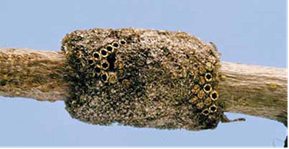
There are many types of tent caterpillar, but the 3 main kinds found are Forest, Eastern, and Western. Forest tent caterpillars are blue with black stripes and white spots on their back. Eastern tent caterpillars are dark brown with a lighter brown strip down their back and are very hairy. Western tent caterpillars are brown with a paler brown underside along with yellow and blue spots on their back.
Tent Caterpillars populations tend to run on 10-year cycles with 2 of those years having very high populations with the other 8 being minor.
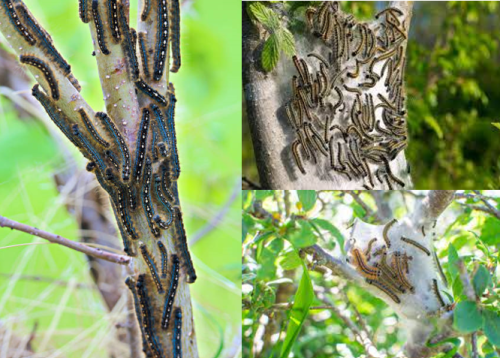
What can be done
The egg clusters can be found during the hosts dormant season (when it’s dropped it leaves) and gently scraped off the tree. There are many parasitic insects and animals that feed on tent caterpillars so the eggs can be left away from the host plant so the larvae have no food when they hatch but their natural controls can still thrive.
The larvae can be removed and disposed of physically. Their silk nests can be destroyed with a stick or a strong spray of water or in some case pruned out of the tree. If the nest is destroyed and the caterpillars are knocked onto the ground most of them will be unable to make it back into the tree and will die.
In cases where physical means of control are not possible contact insecticide can be used to kill the infestation. Note that contact insecticide only kills the insects it touches so there is nothing to stop adults from laying eggs in the tree after.
A systemic insecticide called Treeazin can be used to make the host trees resistant to infestation
Leaf Roller
In Alberta all aspen trees tend to have some leaf roller present. The tell-tale signs of these caterpillars are the characteristic rolled up leaves on the trees. While some target aspens, others target birch, willow, ash, or poplar. Leaf roller caterpillars come in many varieties but live similar lives, their eggs are placed within a bud to over winter and emerge in the early spring when the leaves start to grow. They quickly us their silks to roll a leaf up, using it for protection while they eat. When they get big enough they will roll up a new leaf to pupate inside. The adults emerge as moths to mate and lay legs with almost all the leaf roller species having a single generation per year.
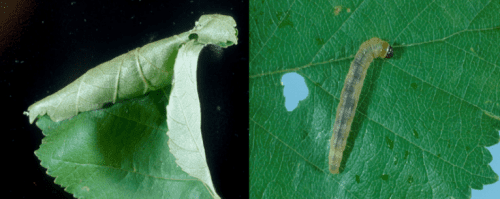
What can be done
While the damage caused by the leaf roller can be unsightly it barely effects the tree’s health. There are no effective treatments for leaf roller as they are protected from contact insecticide sprays and systemic treatments are ineffective. They do have several natural predators like other insects and birds.
Satin Moth
Satin Moth target poplars species in Alberta but will also feed on willow and oak if their normal host is less accessible. The larvae emerge from their eggs in the spring with the emergence of new buds and will feed and grow until June. The larvae are hairy dark caterpillars with large white spots down their back and smaller orange spots to each side of the white. The adults are bright white with a satin texture to their wings. The larvae can completely defoliate trees in severe cases but even then, rarely kill their hosts unless the defoliation continues over multiple years.

What can be done
Satin moths have several natural parasitic predators that target them along with fungal and viral ailments that control their population. In the spring the larvae can be crushed if found or sprayed off the host with a strong spray of water.
Fall Webworm
Fall webworm are easily identified by their large and unsightly web tents they place in the outer canopy of their hosts in the late summer. Fall webworm emerge from their cocoons in late July and mate, then lay their eggs on the underside of their hosts leaves. The moths are white moths with a furry thorax and brown spots on their wings. The eggs will hatch within two weeks and the larvae will spend the next six to eight weeks building their nest and eating the leaves around it. The larvae are hairy greenish brown caterpillars with dark brown and green marks on their back. The larvae will drop to the ground and borrow beneath the soil to build their cocoon and pupate over the winter. They target nearly all deciduous plants in Alberta but rarely do much damage because their larval stage is so late in the season. They are an aesthetic nuisance however due to the large web nests they build.
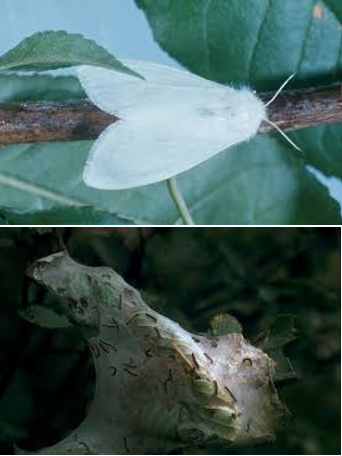
What can be done
The easiest way to control the webworms population is to prune their nests out of the host and destroy them. This should be done before they go to ground in September.
Spiny Ash Sawfly
Spiny ash sawfly target ash trees specifically and skeletonize the leaves throughout the summer before going to ground over the winter. The mature sawflies emerge from their ground cocoons in late May and begin mating and laying eggs in the soft new leaves of the trees. After two weeks the eggs hatch and they larvae will spend the following weeks feeding on leaves and growing. The adult sawflies look like a dark colored wasp with clear wings. The larvae start as smooth green caterpillars with black heads but will develop their signature Y shaped spines as they grow. They will feed on the leaves in groups until early July then they will make their way down the tree to borrow into the ground and build their cocoon to over winter. Spiny ash sawfly rarely does enough damage to threaten the health of a tree but are known hinder the aesthetic appeal of ash trees in urban settings, able to defoliate parts of mature trees and entire young trees.

What can be done
At this time Spiny Ash sawfly populations do minimal damage to the ash trees as a whole and no real control has been established. As with most caterpillars the larvae can be physically destroyed when found but getting all of them will be near impossible. A contact insecticide can be sprayed on them to control populations and in the early spring the ground around the base of the tree can be covered with plastic or landscape fabric to hinder the adult sawflies emergence.
Note – Sawflies are a common pest to trees and there are many types. Other types such as the Yellow headed spruce sawfly target spruce trees. Learn about them in our post dedicated just to them! https://kentuckylandscape.ca/sad-spruce-sawfly/
Pear Slug
Pear Slugs are called slugs because that’s what they look like but are the larval stage for a sawfly. The pear slug targets Hawthorn heavily in Alberta but is also found on cotoneaster, saskatoon, pin cherry, and choke cherry trees. The slug over winters in the ground cocooned close to base of their host, pupating in the spring and emerging as adult sawflies in June/July. The adults look like small black flies and spend the very little time mating before they lay eggs in the leaves of their host. The eggs will hatch after a couple weeks and the slug looking larvae will feed on the leaves, skeletonizing them over the rest of the summer. In some summers with ideal conditions, the pear slug will have a second generation increasing the damage done into the fall.
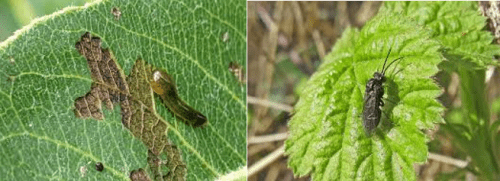
What can be done
In the case of a minor infestation the leaves with slugs on them can be removed and destroyed, destroying the insects at the same time. Pear slug is easily controlled with contact insect controls like Insecticidal soap, neem oil, or contact insecticide sprays.
In Conclusion
The common characteristics of defoliating insects like caterpillars is that they are 1 stage in a life cycle and that the only stage that is problematic is their destructive larval stage. If the larval population is controlled, then usually the damage remains minimal, and the hosts will be fine aside from aesthetic damage. If the tree is defoliated repeatedly over a couple years, it may become stunted or malformed. With severe defoliation over consecutive years the tree may fall into decline. Most of these insects have natural ailments that control their population such as parasitic wasps, predators, fungi, or bacterial infections. Control is advised in severe cases or to preserve the aesthetic of ornamental trees.
Written References
Hugh Philip & Ernest Mengerson, University of Alberta, “Insect Pests of the Prairies”
W.G.H Ives & H.R Wong, Government of Canada Canadian Forestry Service, “Tree and shrub insects of the prairie provinces”
Websites
https://entnemdept.ufl.edu/creatures/trees/forest_tent_caterpillar.htm
https://tidcf.nrcan.gc.ca/en/insects/factsheet/11020
https://tidcf.nrcan.gc.ca/en/insects/factsheet/9504
https://www.forestpests.org/vermont/satinmoth.html
https://d1ied5g1xfgpx8.cloudfront.net/pdfs/31782.pdf
https://tidcf.nrcan.gc.ca/en/insects/factsheet/7688
https://www.gov.mb.ca/agriculture/crops/insects/pear-slug.html


